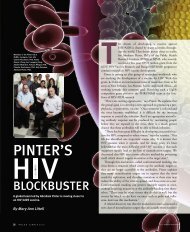changing the course of stroke - New Jersey Medical School ...
changing the course of stroke - New Jersey Medical School ...
changing the course of stroke - New Jersey Medical School ...
Create successful ePaper yourself
Turn your PDF publications into a flip-book with our unique Google optimized e-Paper software.
sedation. Screening CT, supporters say,<br />
can also discern polyps between 0.5 and<br />
1.0 centimeters in diameter. If none are<br />
seen, <strong>the</strong>n a traditional colonoscopy<br />
need not be performed.<br />
However, <strong>the</strong> jury is still out about<br />
whe<strong>the</strong>r CT colonography is as effective<br />
as conventional colonoscopy for <strong>the</strong><br />
detection <strong>of</strong> small polyps. The coexistence<br />
<strong>of</strong> feces is one problem, <strong>the</strong> common<br />
presence <strong>of</strong> numerous diverticula is<br />
ano<strong>the</strong>r. Until definitive pro<strong>of</strong> <strong>of</strong> CT<br />
colonography’s efficacy is established,<br />
one should be wary about relying on it<br />
as <strong>the</strong> only examination to perform as<br />
part <strong>of</strong> an every 5 to 10 year surveillance<br />
for early-stage large bowel cancer.<br />
Cancer <strong>of</strong> <strong>the</strong> lung is <strong>the</strong> most common<br />
lethal malignancy in <strong>the</strong> Western<br />
world. Screening CT can certainly find<br />
small nodules in <strong>the</strong> lung. And once<br />
detected, a thoracotomy can be performed<br />
to remove <strong>the</strong>se tiny tumefactions<br />
with <strong>the</strong> ultimate benefit <strong>of</strong> making<br />
<strong>the</strong> initially asymptomatic patient<br />
cancer-free.<br />
Yet, we do know that a thoracotomy<br />
is not necessarily an innocuous procedure.<br />
Many benign granulomas appear<br />
on CT identical to minuscule cancerous<br />
nodules. In individuals who were previously<br />
infected by tuberculosis or histoplasmosis,<br />
such nodules <strong>of</strong>ten remain as<br />
a legacy. Thus, a thoracotomy for such<br />
patients would be an unnecessary intrusion.<br />
What we do not know is <strong>the</strong><br />
growth rate <strong>of</strong> lung cancers. Do some<br />
stay small and o<strong>the</strong>rs grow even though<br />
all look <strong>the</strong> same under <strong>the</strong> microscope?<br />
Currently, a multi-center study is underway<br />
to answer questions about incipient<br />
bronchogenic carcinoma. Until <strong>the</strong><br />
results are in, one cannot be sure that<br />
CT screening creates more mischief<br />
than benefit.<br />
The rationale behind calcium scoring<br />
<strong>of</strong> <strong>the</strong> coronary arteries is that <strong>the</strong> presence<br />
<strong>of</strong> calcium salts in <strong>the</strong> walls <strong>of</strong><br />
<strong>the</strong>se vessels indicates that <strong>the</strong> patient,<br />
even one who has not experienced chest<br />
pain, is at heightened risk for a cardiac<br />
event. To be sure, it seems plausible that<br />
<strong>the</strong>re is such an association. Yet is it<br />
Why is <strong>the</strong> public so<br />
infatuated with CT screening?<br />
One reason is that a negative<br />
screening CT conveys a sense<br />
<strong>of</strong> immortality.<br />
An image from a full-body, non-contrast<br />
screening CT study. The kidneys are outlined<br />
by fat on ei<strong>the</strong>r side <strong>of</strong> <strong>the</strong> spine<br />
and <strong>the</strong> aorta is calcified.<br />
actual? Many studies have suggested that<br />
it is not <strong>the</strong> hardened vascular coat that<br />
presages an abrupt arterial occlusion but<br />
ra<strong>the</strong>r <strong>the</strong> presence <strong>of</strong> a s<strong>of</strong>t intimal<br />
plaque that is more apt to ulcerate and<br />
precipitate a luminal blockage. Even<br />
more recent refinements in CT technology<br />
have now allowed us, with an intravenous<br />
injection <strong>of</strong> contrast material, to<br />
not only observe <strong>the</strong> calcified vessel wall<br />
but also <strong>the</strong> lumen itself. In effect we<br />
can do a virtual coronary arteriogram<br />
without invading <strong>the</strong> arteries directly.<br />
NJMS experts speak out on topics<br />
<strong>of</strong> interest or controversy<br />
Whe<strong>the</strong>r this fur<strong>the</strong>r advance will be<br />
confirmed as effective is still unknown,<br />
but it has distinct abnormalities over<br />
simple calcium scoring. Moreover, it<br />
may also replace diagnostic cardiac<br />
ca<strong>the</strong>terization for <strong>the</strong> recognition <strong>of</strong><br />
coronary artery disease. The noncontrast<br />
CT scan limited only to vessel<br />
wall calcification has not yet been<br />
proven to be related to a propensity for<br />
coronary occlusion. Moreover, with<br />
newly realized achievements in CT<br />
instrumentation, calcium scoring is<br />
probably obsolete with respect to cardiac<br />
assessment, because <strong>the</strong> interior <strong>of</strong> coronary<br />
arteries can be viewed with a noninvasive<br />
CT test.<br />
We come now to total body screening.<br />
Unlike <strong>the</strong> o<strong>the</strong>r three types <strong>of</strong> CT<br />
evaluation in <strong>the</strong> asymptomatic individual,<br />
<strong>the</strong>re has been no attempt to undertake<br />
prospective blinded studies to<br />
gauge its efficacy. What does this test<br />
assess? In essence, it is a “fishing expedition”<br />
looking at all organs in <strong>the</strong> chest<br />
and abdomen for <strong>the</strong> signs <strong>of</strong> a tumefaction<br />
or an arterial bulge before symptoms<br />
ensue. The fact that it entails an<br />
unfocused search should not automatically<br />
render its dismissal. After all, big<br />
fish are sometimes caught in fishing<br />
expeditions. So, why not do it? Actually,<br />
it is highly unlikely that anything will<br />
be found <strong>of</strong> significance with respect to<br />
<strong>the</strong> saving <strong>of</strong> a life or even identifying a<br />
treatable lesion.<br />
Before proceeding with <strong>the</strong> assessment<br />
<strong>of</strong> its possible value for each organ<br />
under scrutiny we must acknowledge<br />
<strong>the</strong> relevance <strong>of</strong> <strong>the</strong> iron laws <strong>of</strong> testing.<br />
When <strong>the</strong> prevalence <strong>of</strong> a condition is<br />
low, most tests will be truly negative. Of<br />
<strong>the</strong> few that will be positive, most will<br />
be falsely positive. Even if <strong>the</strong> test is<br />
Continued on page 31<br />
N EW JERSEY MEDICAL SCHOOL<br />
11






